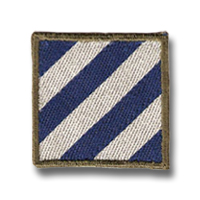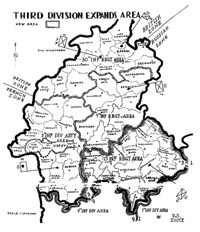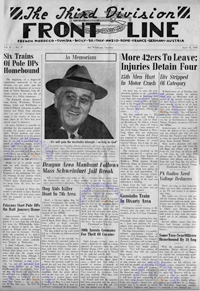| If you do NOT see the Table of Contents frame to the left of this page, then Click here to open 'USArmyGermany' frameset |
||||||||||||||||||||||||||||||||||||||||||||||||||||||||||||
3rd
Infantry Division (Mech) |
||||||||||||||||||||||||||||||||||||||||||||||||||||||||||||
|
|
||||||||||||||||||||||||||||||||||||||||||||||||||||||||||||
|
||||||||||||||||||||||||||||||||||||||||||||||||||||||||||||
|
|
||||||||||||||||||||||||||||||||||||||||||||||||||||||||||||
| Division History - Occupation Period (9 May 1945 - Aug 1946) | ||||||||||||||||||||||||||||||||||||||||||||||||||||||||||||
| May 1945 - Aug 1946 | ||||||||||||||||||||||||||||||||||||||||||||||||||||||||||||
| (Source: Front Line, 16 March 1946) | ||||||||||||||||||||||||||||||||||||||||||||||||||||||||||||
|
||||||||||||||||||||||||||||||||||||||||||||||||||||||||||||
| (Source: FRONTLINE, July 20, 1984) | ||||||||||||||||||||||||||||||||||||||||||||||||||||||||||||
| Editor's note: In the following article, Hallet D. Edson relates a personal account of the 15th Infantry Regiment in the Schweinfurt area during the closing stages of WWII. Edson, then a Colonel, was commander of the "Audie Murphy" regiment from 1945 to 1946. Marne Legacy Schweinfurt, Germany 1945-46 By Halet D. Edson On the 11th of April, 1945, Marlene Dietrich and her traveling show were scheduled to put on.a performance for our regiment, the 15th Infantry of the Third Infantry Division. At that time we were in division reserve and located just north of Schweinfurt in the vicinity of Rottershausen and Rannungen. We really "put on the dog," by entertaining Miss Dietrich for lunch in our hastily set up Regimental Headquarters Mess in the storage room of a small hardware store. We served the usual delicacies, a variety of "C" rations; no other food had kept up with our rapid advance. Unfortunately the luncheon was cut short for me as I got a call to "move out." The regiment had just received orders to continue the attack and was only able to leave behind the 1st Battalion, in regimental reserve, to attend the show. From all reports it turned out to be pretty good! That afternoon we by-passed Schweinfurt and, coming down from the hills, secured the castle at Mainberg, the home and office of Willy Sachs, one of the three Schweinfurt ball bearing "Barons." An interesting sidelight occurred as our rapidly advancing troops found that in the lower floors of the castle a brick wall had been hastily erected. The wall was torn down and many of Willy Sachs' records were found to have been cached in the recess behind the wall. We continued the attack to the east and entered Bamberg by nightfall of the 18th. That "fresh brick wall" wasn't the only example of a secret room in this beautiful old castle said to date back to around 1066. We found another concealed spot in February of 1946, when our regiment moved from the Wetzlar area to the Schweinfurt area and I established our headquarters offices in Mainberg Castle. The 15th Infantry Headquarters was set up in a building just across from a large German kaserne (Webmaster: later on known as Ledward Barracks) on the western outskirts of the city, on the road toward the airport. Captain John S. Sullivan was my Headquarters company commander and Captain Maurice W. Kendall was my regimental adjutant. These two, Sullivan and Kendall, shared a delightful room in the castle just off the dining room and one day asked me to stop in their room as they had found another "secret compartment" which they described as a walk-in safe in the wall. "Can you find it?" they asked. Well, it was quite a search. After finally locating a faint arc shadowed in the carpet, I probed the wall and the set of doors and drawers in the vicinity until I found one drawer that, with an extra pull, unlocked the entire wall section. It pivoted smoothly around to the left, revealing a steel wall safe. Alas, all the "secret documents" had disappeared by that time. The 1st Battalion was located at Wildflecken, the 2nd at Hammelburg Lager with about 6,000 German POWs, the 3rd at Mellrichstadt on the Russian border, and an attached Anti-aircraft Battalion, commanded by LTC Frank Ebey, at Wuerzburg. Across the street from our Regimental Headquarters was a huge German Army Kaserne housing about 12,000 Polish displaced persons. I used the hayfield across the river from Mainberg to land one of the Division L-4's while making flying trips around the area and to Division Hewadquarters far north of Frankfurt. I was able to cross river by a rowboat courtesy of a local German resident of the village. In Mainberg we also kept several horses we had liberated from a Hungarian Riding School soon after the war ended. This gave us the opportunity for pleasant riding up in the hills. These were the same hills that bristled with 88-mm Anti-aircraft guns during the war and were responsible for shooting down so many of our bombers in the raids on the three ball bearing factories: Schaefer, Sachs, and Kugel-Fischer. Although much of the downtown area had been destroyed, the people were industriously working to haul away the rubble and rebuild. The Schweinfurt Airfield, located a couple of miles down the road toward Wuerzburg, was loaded with U.S. aircraft being systematically destroyed -- most sad! At that time, Wuerzburg was quite desolate. The city had been fire bombed and only the stone and brick walls were standing, with pipes and radiator's hanging from the masonry. At the end of May 1946, my wife, Faith, received orders to join me and by that time I had requisitioned an attractive two-story house complete with yard, a maid and furnished. She was awaiting a "port call" when I received orders to return immediately to CONUS to attend the course at the Naval War College commencing in June. Thus ended my tour in Schweinfurt, and I would certainly like to return sometime and see the changes that have taken place in these thirty years. |
||||||||||||||||||||||||||||||||||||||||||||||||||||||||||||
| (Source: Front Line, 25 May 1946) | ||||||||||||||||||||||||||||||||||||||||||||||||||||||||||||
| DPs Move Out
As 7th Hq Co Enters Fulda Over 600 Displaced Persons living in Fulda's Hindenburg Kaserne will be transferred to other DP camps this week, 1st Lt Stanley Teiser disclosed 20 May. With the departure of the DPs, men of the 333rd Engineer Bn and civilian labor will ready the kaserne for the arrival of 7th Regt Hq Co. The company is expected to move into the kaserne during June in conjunction with the consolidation of the 7th Regt in Fulda. Plans for the renovation of the future 7th RHQ billets include the installation of a new central heating ... as well as painting and remodeling. Of the 688 people scheduled to be transferred to other DP camps, 320 will go to Schwarzenborn camp and the rest will be sent to Konstantine DP camp in Fulda. |
||||||||||||||||||||||||||||||||||||||||||||||||||||||||||||
|
|
||||||||||||||||||||||||||||||||||||||||||||||||||||||||||||
| (Source: Front Line, 25 May 1946) | ||||||||||||||||||||||||||||||||||||||||||||||||||||||||||||
|
30th Hq Moves
From Kassel to Roth Westen
(sic) |
||||||||||||||||||||||||||||||||||||||||||||||||||||||||||||
|
|
||||||||||||||||||||||||||||||||||||||||||||||||||||||||||||
| The Third Division Front Line - Some of the issues published while in Germany | ||||||||||||||||||||||||||||||||||||||||||||||||||||||||||||
| ISSUES IN COLLECTION | ||||||||||||||||||||||||||||||||||||||||||||||||||||||||||||
|
||||||||||||||||||||||||||||||||||||||||||||||||||||||||||||
| Related
Links: 3rd Infantry Division - Official Homepage of The Society of the 3rd Infantry Division, United States Army "ROCK OF THE MARNE!" The oldest continuous U. S. Army Division Association. (Excellent online newsletter!!) Fort Stewart, GA - Home of the 3rd Infantry Division (M) (today) |
||||||||||||||||||||||||||||||||||||||||||||||||||||||||||||


